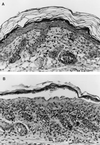Recombinant Staphylococcus aureus exfoliative toxins are not bacterial superantigens
- PMID: 10769013
- PMCID: PMC97528
- DOI: 10.1128/IAI.68.5.3048-3052.2000
Recombinant Staphylococcus aureus exfoliative toxins are not bacterial superantigens
Abstract
Staphylococcal scalded-skin syndrome is an exfoliative dermatitis characterized by the separation of the epidermis at the stratum granulosum. This disruption is mediated by one of two Staphylococcus aureus exotoxins, exfoliative toxins A and B (ETA and ETB). Both ETA and ETB have been reported to be bacterial superantigens. A controversy exists, however, as other data indicate that these exotoxins are not superantigens. Here we demonstrate that recombinant exfoliative toxins produced in Escherichia coli do not act as T-cell mitogens and thus are not bacterial superantigens. These data fit the clinical profile of the disease, which is not associated with the classic symptoms of a superantigen-mediated syndrome.
Figures


Similar articles
-
Understanding the mechanism of action of the exfoliative toxins of Staphylococcus aureus.FEMS Immunol Med Microbiol. 2003 Nov 28;39(2):181-9. doi: 10.1016/S0928-8244(03)00225-6. FEMS Immunol Med Microbiol. 2003. PMID: 14625102 Review.
-
Skin findings of Staphylococcus aureus toxin-mediated infection in relation to toxin encoding genes.Pediatr Infect Dis J. 2013 Jul;32(7):727-30. doi: 10.1097/INF.0b013e31828e89f5. Pediatr Infect Dis J. 2013. PMID: 23446443
-
Clinical manifestations of staphylococcal scalded-skin syndrome depend on serotypes of exfoliative toxins.J Clin Microbiol. 2005 Apr;43(4):1890-3. doi: 10.1128/JCM.43.4.1890-1893.2005. J Clin Microbiol. 2005. PMID: 15815014 Free PMC article.
-
Toxin involvement in staphylococcal scalded skin syndrome.Clin Infect Dis. 1997 Dec;25(6):1369-73. doi: 10.1086/516129. Clin Infect Dis. 1997. PMID: 9431380
-
Exfoliative toxins of Staphylococcus aureus.Toxins (Basel). 2010 May;2(5):1148-65. doi: 10.3390/toxins2051148. Epub 2010 May 25. Toxins (Basel). 2010. PMID: 22069631 Free PMC article. Review.
Cited by
-
Interaction of host and Staphylococcus aureus protease-system regulates virulence and pathogenicity.Med Microbiol Immunol. 2019 Oct;208(5):585-607. doi: 10.1007/s00430-018-0573-y. Epub 2018 Nov 27. Med Microbiol Immunol. 2019. PMID: 30483863 Review.
-
Children with atopic dermatitis who carry toxin-positive Staphylococcus aureus strains have an expansion of blood CD5- B lymphocytes without an increase in disease severity.Clin Exp Immunol. 2001 Aug;125(2):184-9. doi: 10.1046/j.1365-2249.2001.01620.x. Clin Exp Immunol. 2001. PMID: 11529907 Free PMC article.
-
Toxin levels in serum correlate with the development of staphylococcal scalded skin syndrome in a murine model.Infect Immun. 2001 Aug;69(8):5193-7. doi: 10.1128/IAI.69.8.5193-5197.2001. Infect Immun. 2001. PMID: 11447206 Free PMC article.
-
Keratinocytes produce IL-6 in response to desmoglein 1 cleavage by Staphylococcus aureus exfoliative toxin A.Immunol Res. 2013 Dec;57(1-3):258-67. doi: 10.1007/s12026-013-8467-y. Immunol Res. 2013. PMID: 24287883
-
Bullous impetigo in children infected with methicillin-resistant Staphylococcus aureus alone or in combination with methicillin-susceptible S. aureus: analysis of genetic characteristics, including assessment of exfoliative toxin gene carriage.J Clin Microbiol. 2011 May;49(5):1972-4. doi: 10.1128/JCM.01742-10. Epub 2011 Mar 23. J Clin Microbiol. 2011. PMID: 21430094 Free PMC article.
References
-
- Arbuthnott J P, Kent J, Lyell A, Gemmell C G. Studies of staphylococcal toxins in relation to toxic epidermal necrolysis (the scalded skin syndrome) Br J Dermatol. 1972;86:35–39.
-
- Bailey C J, Deazavedo J, Arbuthnott J P. A comparative study of two serotypes of epidermolytic toxins from Staphylococcus aureus. Biochim Biophys Acta. 1980;624:111–120. - PubMed
-
- Bohach G A, Fast D J, Nelson R D, Schlievert P M. Staphylococcal and streptococcal pyrogenic toxins involved in toxic shock syndrome and related illnesses. Crit Rev Microbiol. 1990;17:251–272. - PubMed
-
- Cavarelli J, Prevost G, Bourguet W, Moulinier L, Chevrier B, Delagoutte B, Bilwes A, Mourey L, Rifai S, Piemont Y, Moras D. The structure of Staphylococcus aureus epidermolytic toxin A, an atypic serine protease, at 1.7 A resolution. Structure. 1997;5:813–824. - PubMed
Publication types
MeSH terms
Substances
Grants and funding
LinkOut - more resources
Full Text Sources
Other Literature Sources

